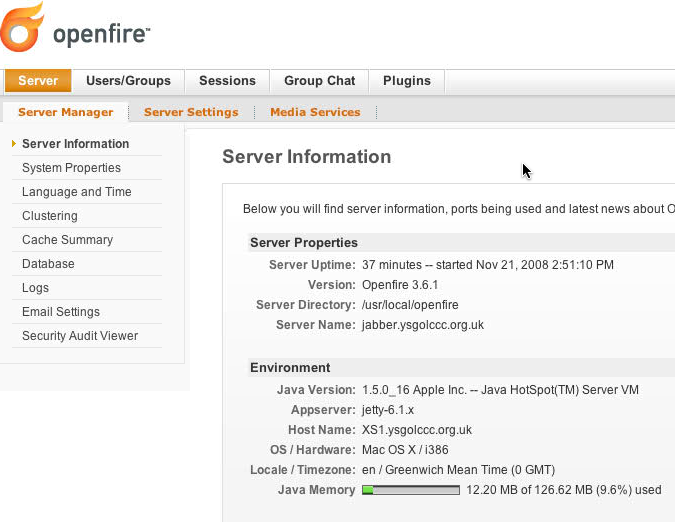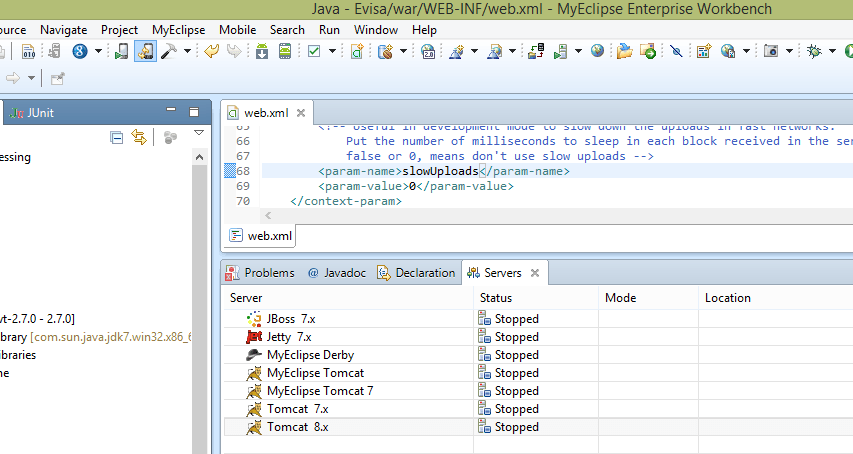Re: jetty-dev Jetty server - java.net.BindException: Address already in use (on MAC OS X) From: George Goglidze Date: Wed, 1 May 2013 14:13:11 +0100. Eclipse Jetty provides a Web server and javax.servlet container, plus support for HTTP/2, WebSocket, OSGi, JMX, JNDI, JAAS and many other integrations. These components are open source and available for commercial use and distribution. Eclipse Jetty is used in a wide variety of projects and products, both in development and production. For information on installing, setting up and managing the server, consult the Jetty documentation. Defining the Server Inside the IDE. To define a server: Before you run an application for the first time, the Run Debug command allows you to define your server. To define a new server, right click on J2EE Server and choose New.
After upgrading to 7.3.2, Jetty should be configured based upon your current JBoss configuration. All customer configurations for Jetty are located in the jetty/base folder.
During upgrade or a new installation, the following files will be created for you in Jetty:
- jetty/base/etc/installation.properties
- jetty/base/etc/perc-ds.xml
- jetty/base/etc/perc-ds.properties
The installation.properties file will contain settings for HTTPS if you had HTTPS set up prior on the JBoss installation. Jetty will exclusively start with HTTP until you enable HTTPS.

Directions on how to Enable HTTPS and configure HTTP and HTTPS ports
Starting Jetty through Command line
Patch 732_20171004 updated The StartJetty.sh script for linux to be able to safety run as root, or the user that owns the Rhythmyx root folder. It will show an error if run as any other user. It will also check to make sure the instance is not already running in another shell or as a service.
Windows users should ensure that the current JBoss install is not already running and that any other instance is not already running.
Windows
Linux
Jetty will always run as the owner of the Rhythmyx base folder since Patch 732_20171004. Installing the service will change ownership of the contained files and folders to ensure they are consistent.
To find who is the owner in user, group format:
Next cd into the {RHYTHMYX_HOME}/jetty directory
Installing the Rhythmyx Jetty Service and disabling the old JBoss service
Installing the Jetty Service will allow Rhythmyx to start via service rather than manually, and allow it to startup when the system boots up.

Ensure that Rhythmyx is not already running. Additionally, the old Rhythmyx service should be disabled so that it does not start automatically on Startup. Otherwise the Jetty Service will conflict with the old Rhythmyx JBoss service.
Disabling the old Rhythmyx JBoss service on Windows
Disabling the old Rhythmyx JBoss service on Linux
Since Patch 20171007 The service install will warn if there is already a JBoss service installed. You can automatically remove this service with the cleanupJBoss argument to the install-jetty-service.sh
Installing the new Rhythmyx Jetty service on Windows

Execute the following batch script to install the jetty service: install-jetty-service.bat install
Installing the new Rhythmyx Jetty service on Linux
Starting and stopping the Jetty service
After installing the Jetty service, it will automatically start every time the system is booted.
Windows
Jetty Server For Mac Mojave
To start and stop the Jetty Service on Windows, use the same install batch file to start and stop Jetty, using the following parameters:
install-jetty-service.bat startYou can also use windows regular service management tools.Jetty Server Join
Linux

You will usually have to logged in as root or use the sudo command and have permissions to start and stop the services.
Ubuntu/Debian/RHEL6
To start and stop the Jetty Service on Ubuntu, Debian, and RHEL6 use the following commands:
service rxjetty startDownload Jetty Server For Mac
CentOS 6
To start and stop the Jetty Service on CentOS6, use the following commands:
chkconfig rxjetty onRHEL7/CentOS 7
To start and stop the Jetty Service on CentOS 7 and RHEL7, use the following commands:
systemctl stop rxjettyRemoving all JBoss related Files
Now that JBoss is disabled and Jetty is up and running, you may now remove all JBoss related files.
Please review Removing JBoss from install, and have Rhythmyx exclusively use only Jetty on what files should backed up and what files can be removed.
After validation, the next step in the SSL process is to complete the technical installation process on your web server or hosting platform. This process will require the certificate requester or technical contact to have direct access to their web server or hosting platform to configure the necessary SSL files accordingly. The below articles contain step-by-step instructions on how to install an SSL certificate on the most common web servers and hosting platforms. You will also find instructions for systems wherein an SSL certificates must be enabled, not necessarily installed.
Amazon Web Services (AWS)
Apache Open SSL
Citrix Secure Gateway
cPanel 11.x (Paper Lantern Theme-Modern)
F5 BIG IP (version 8 and under)
F5 BIG IP (version 9)
Jetty Java HTTPS Servlet Web Server
LiteSpeed
Mac OS X El Capitan (v.10.11)
Media Temple (GRID)
Microsoft Exchange 2007
Microsoft Exchange 2010
Microsoft Exchange 2013
Microsoft Exchange 2013 EAC
Microsoft IIS 5 & 6
Microsoft IIS 7
Microsoft IIS 8
Microsoft IIS 10
Microsoft Office Communications 2007
Nginx (OpenSSL)
Odin (Plesk v.11, 12, & 12.5)
Plesk 10
Tomcat
Web Host Manager (WHM)
Webmin
WooCommerce
Joomla
Drupal
BigCommerce
Google App Engine
Zimbra Mail Server